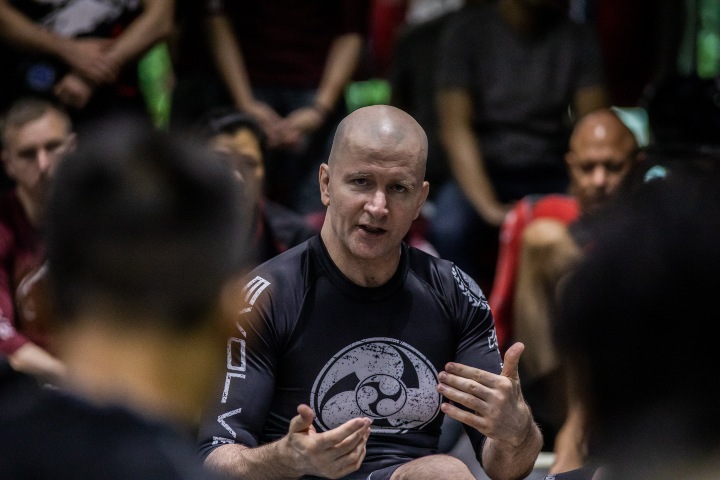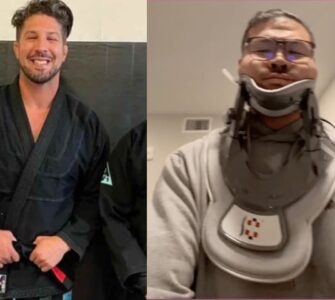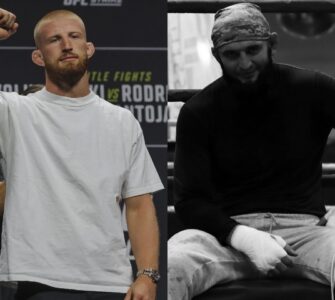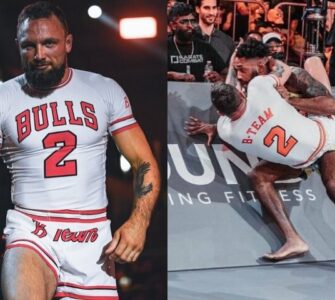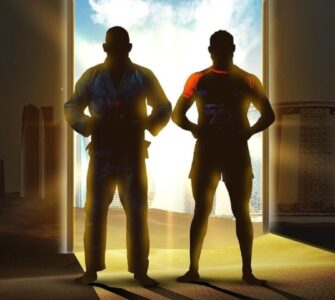John Danaher is a BJJ black belt under Renzo Gracie, and is known as one of the best BJJ instructors in the world.
The New Zealand born black belt has been praised by the BJJ community as being a master and brain of the art. Danaher is a highly intelligent individual, who has a Master degree in philosophy from Columbia University, and is totally focused on the evolution and improvement of Jiu-Jitsu. He is also the submission coach of none other than former UFC Welterweight Champion George Saint Pierre, Travis Stevens, Garry Tonon, Eddie Cummings and Gordon Ryan.
Danaher trains and teaches Jiu jitsu at Renzo Gracie’s Academy in New York.
Danaher shared his thoughts on Facebook about role models in martial arts and what it takes to be a champion:
“On role models: I am a huge believer in the power of role models to improve and inspire our behavior. I myself was extremely fortunate to have superb role models in every phase of my life, particularly in jiu jitsu. Often I use the example of my senior students to guide and help beginning students and inspire them when they most need it. One of the most inspirational and the most well known is the great Georges St-Pierre, whose story can serve as one of the very best to move aspiring martial artists in the right directions. When I first met Georges, he was fighting in the TKO and UCC federations, local Canadian MMA shows. He would drive or take a bus down to Manhattan to train in Manhattan at the Renzo Gracie academy where I was teaching classes on the weekends (a seven hour drive each way – you can see the level of his dedication and drive even in those early days). At that time he was just a fresh faced kid who spoke almost no English with a strong sense of drive and some degree of athleticism. He was a blue belt who impressed me with his physical toughness, but was clearly lacking in technical skill. I can honestly tell you that there was nothing you could see him doing on the mat that would suggest that he would one day be a world champion. He was just another tough blue belt among many. An interesting question becomes – what made him progress so rapidly in skill level from these inauspicious beginnings to the level he is today and what can we learn from this to aid our own progress? I believe there are a number of factors.
(A) Directional: Even in this early days, Georges had a clear goal (to be a UFC champion) and a fixed program to get to that goal (winning enough local shows to get to the UFC and training hard to perfect the skills required to win at the highest levels of UFC competition) and the determination, self discipline and mind set to stay with that program until the goal was reached (he proved that to me simply by traveling seven hours each way across an international border into a country whose language he did not speak to train). Obviously this is an extreme case, but the point remains – if you want progress, clearly define your goal, whatever it is; then, figure out an effective program which is likely to get you to that goal and then exercise the drive and self discipline to stay with it (you may have to modify it in the light of experience as you go – that is OK) until you get there. Excellence in any endeavor always demands these three elements. Obviously you will have a mix of short term and long term goals. So for example, you might have the goal of attaining a purple belt. This might be your medium term goal. You create a program based upon the skill development you believe will be necessary to get to that level. You identify the skills you believe are the most important to acquire and set aside time to drill them and utilize them in live training. You exercise self discipline in working on them until your level is satisfactory and you become a threat to the purple belts you train with and overwhelm most of the blue belts you train with. At this point your goal is essentially reached and now you need only the patience for your teacher to recognize your advances and reward you.
(B) Pedagogical: A crucial theme in Georges’ development has always been a strong mastery of the fundamentals of the various combat sports he engages in. All too often beginning athletes want to learn some exotic new move or trend that takes them away from the key components of the sport they play. No matter how unorthodox they may appear on the surface, every champion is first and foremost, strong in the fundamentals of his sport. Like everyone who progresses quickly, Georges spent the majority of his training time perfecting the skills that he would use every day of training, rather than fritter away time on moves that he might use once a month. A second crucial theme is this; Georges looks for training information from many sources (being sure to check their reliability by some sensible means, such as success in international competition, producing many good students etc). I have been Georges primary jiu jitsu coach (as opposed to an auxiliary coach prior to this) since shortly after his first match with Matt Hughes in late 2004 (the only exception to this was the lead up to to his two fights with Matt Serra where I had a gentleman’s agreement to coach neither fighter since I was close to both of them).
There are some things I teach quite well, other things not so well – as such, I always encourage Georges to train with other auxiliary jiu jitsu coaches to make sure any deficiencies in my coaching are covered by others. So for example, I strongly encouraged Georges to begin training with my good friend Roger Gracie whenever he was on business in England. Do not limit your knowledge to that of your current instructor, especially as you progress to a higher level. Of course you will have a primary instructor from whom most of your knowledge will come, but listen to other reputable sources also – they can often add some key insight that takes you forward. A third theme is this; Georges makes a concerted effort to study the greatest people in the various combat sports he studies. When we travel together, I always bring a tape of some great athlete which we watch as we eat and relax after a day of training. I will put on a DVD of Marvin Haggler, Yasuhiro Yamashita, Arsen Fadzaev, Braulio Estima, Dieselnoi or some other great combat athlete in their respective discipline and we watch in awe as the skills of a champion enlighten, embolden and inspire us.
Become a student of greatness. Let their example shine a light that illuminates your way and lifts you to a higher level. A fourth theme is this; learn the difference between training and fighting. When you train, focus only upon increasing your skill set. Play around with new moves and positions and learn the subtle details that make them work well. Do not overly concern yourself with who wins and who loses – that is only important when you compete, not when you train. Learn to play jiu jitsu, rather than fight jiu jitsu in the training room. I always told Georges this – I demand that you train every day, but I do not demand that you train hard every day. Unless there is a fight coming up and camp is in session, our training over the last decade usually has an experimental feel to it. This is a healthy thing and makes for fast progress. There are other factors involved in training efficiently, one day I will elaborate upon them at length, but for now these beginnings, so well demonstrated by Georges St-Pierre, will serve to aid the progress of a beginning student.
(C) Lifestyle Choice: I believe a big part of it is Georges commitment to the lifestyle of a martial artist rather than that of a fighter. Central to his success is his adherence to the notion of kaizen – the idea of continuous daily improvement in performance of a skill over a lifetime. Most people in MMA see technique as a means to end (victory over a given opponent) A martial artist sees the learning of technique as an end in itself – the mastery of a craft that is a reward in itself.
Fighters typically train when they have a fight coming up. Georges trains every day and will continue to do long after his fight career is over. He was a martial artist who happened to fight for a living, rather than a fighter who happened to to martial arts. Every day presents an opportunity to deepen your knowledge of the techniques that comprise the sport. This daily incremental progress over time is something I saw in a young Georges St-Pierre when he first came to New York as a fresh faced kid with nothing but drive and a dream. He had absorbed it from his early Karate training and it took him from a scrappy blue belt to advanced level expert in many combat disciplines, a UFC title and arguably the greatest fighter of all time. Georges sets long term goals and works patiently and diligently to get them. Too many fighters undermine themselves with short term thinking. As such they often fall victim to what I call “the partialist fallacy.” This is the (erroneous) belief that you can learn some fragments of a given combat sport and then incorporate them into a successful MMA career over the long term. So, for example, a fighter with a strong boxing background will say, “show me some wrestling takedown defense and some grappling submission hold escapes and I will fight MMA.” Such a route is doomed to failure in the long term. In the heat of elite competition, partial knowledge of a few takedown defenses will not stop a good wrestler, nor will knowing some moves to get out of a triangle and arm lock save you from a submissions specialist.
You cannot learn fragments of a combat sport in a short time and expect long term success in MMA. Rather, you must learn the complete sport of wrestling, of jiu jitsu, of judo, of boxing, of Muay Thai etc. This is obviously a very long term project, but it was one that Georges made early in his career and continues to work on to this day – adding little pieces of knowledge one day at a time that ensure that his performance continues to improve over a lifetime. There is much, much more to be said about this great man, but I hope these basic reflections on a part of his life and character move you to see possibilities and feel a drive that was previously lacking.”

